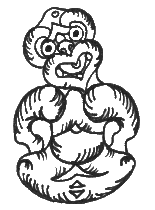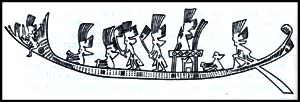 Graven image of Ruaki, carved by the Nari-Kamuda fleet-tribe
Graven image of Ruaki, carved by the Nari-Kamuda fleet-tribe
About the Moa Ruaki
The Moa-Ruaki are sea-going nomads who travel amongst the islands on the outer edges of the "civilised" world. Their name means "People of Ruaki", after their most famous folk hero.
Physical
The Moa-Ruaki are humans, slightly shorter and more slender than average with nut-brown skin. Hair is black and curly, and eye colour is predominantly green, with some grey or blue. Their faces tend to be broad and round. Scarring is a common form of body adornment. Women and high-ranking men may wear elaborate clasps in their hair, usually carved from bone or coral.
They wear little clothing, living as they do in the warmer areas of the world. Little more than a loin-cloth or sarong is the normal practice for either sex, sarongs being the more formal garment. Children often go naked and it is acceptable even in adults.
Way of Life

Carving of a kanu-ri, Nari-Kamuda fleet-tribe
The Moa-Ruaki travel the seas in fleets of small boats, with maybe one or two larger ships. These are lashed together in times of storm or for social functions, otherwise each boat is the "hearth" of one family. They travel in a set pattern, stopping for up to two months at a time at various islands along their route. They partly follow the shoals of fish upon which they live, but certain island stops are undertaken based upon the fruiting of local crops, or due to religious requirements.

Mythology and Magic
The attitude to life of the Moa-Ruaki is a strange mixture of carefree cheerfulness and a hard-nosed fatalism. Sea-going life is tough and breeds a certain cynicism amongst them - they expect to lose a few ships each season. On the other had, because they accept this risk they tend to just get on with life and enjoy it. Their religious life is a mixture of hero-worship of their founder Ruaki balanced by fearful apologism for his actions against the creator god Ko. On the one hand their myths teach that you can trick the gods and fate, on the other they teach that there is a price to pay for such behaviour.


|
Mythology and Magic
Way of Life
|